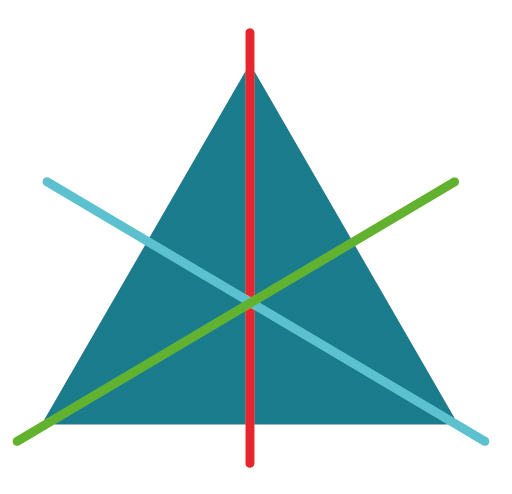2.2 Reflections of a triangle
The equilateral triangle can be reflected and yet remain unchanged – can you see where the reflection line must be drawn for this? The triangle must be cut into two equal halves, with the line running from one corner to the midpoint of the opposite edge. In fact, you’ll notice three such lines can be drawn.
Let’s focus on the reflection line that cuts through the corner in position P3. What effect will this have? Use your triangles from Activity 1 to test it out.
Activity 2 Reflecting your triangle
Put the triangle back into the original position from Activity 1. Now turn it over, keeping C3 at position P3. How have the labels moved?
Answer
In this case, the top corner stayed where it was, so you have 3 → 3, while the other two corners swapped places, so 1 → 2, 2 → 1.
Is this the same as a rotation?
Answer
No. Think back to Activity 1’s rotations. If any corner stayed put, they all stayed put. If any moved, they all moved. This is a new symmetry of the equilateral triangle.
What happens if you do the same reflection twice? Since one corner stays put and the other two swap positions, performing the same transformation twice brings us back to the original situation.
What about combining two different reflections? Try this out and see what happens.
Put the triangle back into the original position again. Now turn it over, keeping the top corner in the same position. Then turn it over again, this time keeping the left-hand corner in the same position. How have the labels moved?
Answer
As before, the first transformation swapped C1 and C2, keeping C3 fixed in place at the top.
When you turn it over again, keeping the corner in the lower left fixed, you swap the corners in the lower-right and top positions. You now have corner C2 in the lower-left, corner C3 in the lower-right and corner C1 in the top position. This means you’ve moved 1 → 2 → 3, 2 → 1 → 1 and 3 → 3 → 2. The overall result of the two reflections is 1 → 3, 2 → 1 and 3 → 2.
What single transformation is this equivalent to?
Answer
Looking back at the cycle diagram, this is equivalent to an anticlockwise rotation by 240 degrees, or a clockwise rotation by 120 degrees.
So, what you’ve seen here is that combining two reflections produces a rotation! As it turns out, this is true for all combinations of two reflections. You might like to continue testing this for yourself.
This all leads to another interesting question: what happens if you combine a rotation and a reflection?

